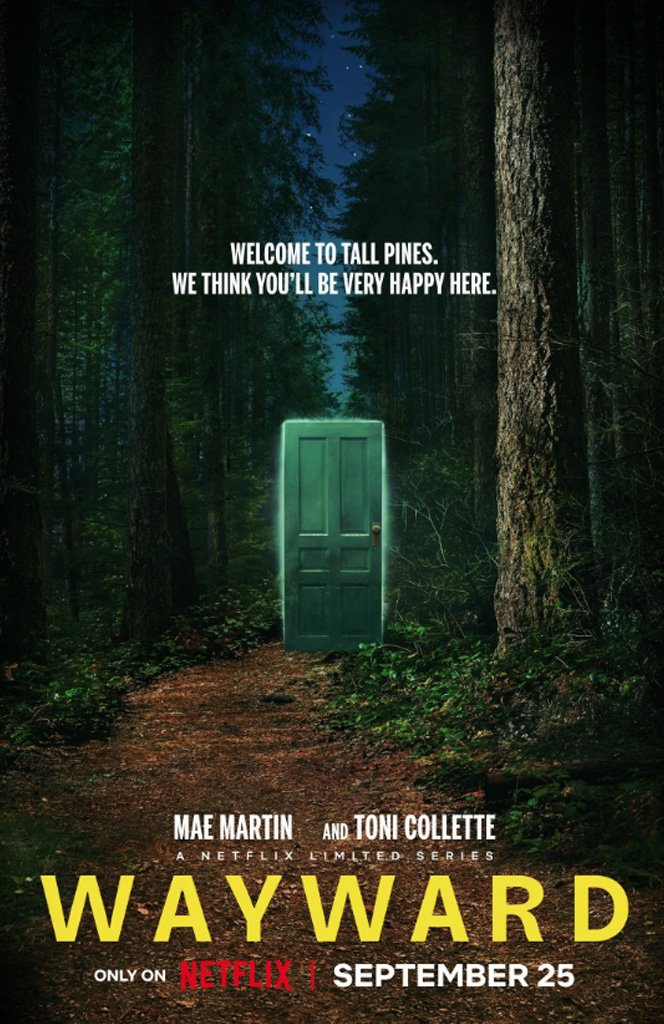Wayward After vanishing for over a decade, Eli Cross, a once-celebrated prodigy with a tainted past, returns to his desolate hometown—a place that still holds him responsible for a tragedy he swears he didn’t cause. As Eli attempts to rebuild what’s left of his life and reconnect with estranged faces, new disappearances begin to mirror the past. Whispers of old secrets resurface, and the town once again turns against him.
Table of Contents
Introduction
“Wayward” is a psychological drama-thriller that dives deep into the shadows of a forgotten town and the mind of a man seeking redemption. More than just a mystery, it’s a slow-burning emotional journey through buried secrets, betrayal, and the thin line between guilt and innocence. At its core lies a question: What happens when you return to the place that broke you — and it needs you to save it?
Set in a cold, melancholic town where nothing is as it seems, “Wayward” explores how memory, trauma, and lost time can become both a prison and a weapon. It’s a story about confronting the ghosts of your past — both real and imagined.

Release Date
Wayward, releasing on September 25, 2025, is a gripping psychological thriller about a man returning to his haunted hometown to confront the secrets that destroyed his past. As new disappearances echo old tragedies, he must face the truth—before it consumes him again.
WAYWARD OFFICIAL TRAILER NETFLIX
Main Cast & Their Roles – Wayward
- Toni Collette as Dr. Evelyn Hargrove
A reclusive trauma psychologist with ties to Eli’s past and the town’s buried secrets. - Alyvia Alyn Lind as Lena Cross
Eli’s brilliant but troubled teenage niece, whose connection to recent disappearances runs deeper than she realizes. - Brandon Jay McLaren as Detective Ray Halstead
A local officer torn between justice and loyalty, investigating the re-emerging mystery. - Hope Davis as Margaret Cross
Eli’s estranged mother, battling dementia and holding fragmented truths about the past. - Joshua Close as Eli Cross
The central protagonist. A former prodigy seeking redemption while confronting his haunted past. - Mae Martin as Jules Avery
A podcaster and outsider obsessed with the original case, who arrives in town chasing the truth. - Matt Dillon as Sheriff Tom Weller
The town’s aging sheriff who covered up more than he revealed—now forced to face the consequences. - Patrick Gallagher as Father Mason Burke
The local priest with a dark past, who knows more than he lets on. - Patrick J. Adams as Dr. Caleb Voss
A charming psychologist working with local authorities—whose motives aren’t entirely pure. - Sarah Gadon as Rachel Greene
Eli’s childhood love, now a single mother hiding secrets that could crack the case wide open. - Sydney Topliffe as Young Sarah / Flashback Version
Portrays Rachel during key moments of the past that unravel the mystery in present day.
Key Themes – Wayward
- Redemption vs. Condemnation
The central struggle of Eli’s journey—can a man outrun his past, or is he forever bound by it? - Memory and Truth
The series explores how memories can be unreliable, fragmented, or manipulated—and how truth can be buried beneath personal perception. - Family and Estrangement
Broken relationships, generational trauma, and the complexities of family loyalty drive much of the emotional core. - Small-Town Secrets
Wayward examines how communities protect their own—and what they’re willing to hide to maintain the illusion of normalcy. - Innocence Corrupted
Children play a symbolic and literal role in the mystery, highlighting lost innocence and generational cycles of harm. - Psychological Isolation
Eli’s internal world is one of isolation, guilt, and doubt—a reflection of trauma’s long-lasting effects. - Faith and Doubt
Through religious characters and motifs, the series wrestles with belief systems, moral ambiguity, and justice. - Media and Obsession
With the inclusion of a podcaster and sensationalized narratives, Wayward critiques society’s obsession with tragedy and crime as entertainment.
Challenges & Environments
Psychological Challenges
- Eli’s Inner Demons: Haunted by guilt, fractured memories, and unresolved trauma, Eli struggles to separate truth from hallucination.
- Unreliable Narratives: Conflicting accounts and distorted flashbacks keep both Eli—and the viewer—unsure of what’s real.
- Trust Issues: No one is fully trustworthy—not family, law enforcement, or even Eli himself.
Environmental Challenges
- The Town of Greybridge:
A cold, decaying town full of hidden pasts and wary stares. Isolation is physical as much as emotional. - Dense Forests & Frozen Lakes:
Nature becomes a character—offering places to hide secrets, but also places where the past resurfaces. - Abandoned Buildings & Churches:
These crumbling structures mirror the collapse of trust and faith in the town—and often serve as key crime scenes. - Constant Overcast & Rain:
The weather is a visual metaphor for grief and looming dread, enhancing the town’s oppressive atmosphere.
Social & External Pressures
Media Intrusion: A true-crime podcaster reignites the old scandal, drawing unwanted national attention.
- Community Suspicion: Eli is constantly watched, blamed, and marginalized by townsfolk still unwilling to forgive.
- Systemic Corruption: Law enforcement, religious figures, and the local elite are entangled in a decades-old cover-up.
Visual Style
Wayward leans heavily into a cinematic, atmospheric, and emotionally immersive visual language designed to mirror the psychological depth of its characters and the haunting mystery at its core.
Color Palette
- Muted tones: Grays, desaturated blues, forest greens, and soft amber tones dominate, enhancing the melancholic feel.
- Autumn & Winter hues: Symbolizing both decay and isolation. Warm tones are reserved for flashbacks, creating emotional contrast.
Lighting Style
- Low-key lighting: Shadows dominate interiors, creating an oppressive and uncertain mood.
- Natural/diegetic sources: Candlelight, flickering lamps, car headlights—used to heighten realism and suspense.
- Contrast flashbacks: Bright, dreamlike lighting with lens flares to signal memory or distortion.
Camera Work
Handheld camera: Used during emotionally charged or chaotic scenes to enhance intimacy and tension.
- Slow dolly shots: Build suspense and give a voyeuristic feel—as if someone is always watching.
- Long takes & still frames: Emphasize discomfort, reflection, or build dramatic silence.
- Close-ups: Focus on micro-expressions, especially during interrogations or confrontations.
Framing & Composition
Negative space: Characters are often placed off-center, lost in the frame—visually echoing their isolation.
- Mirrors & reflections: Repeated use symbolizes duality, fractured identities, and hidden truths.
- Foreground obstruction: Blurred branches, door frames, and glass frequently interrupt clean shots, reflecting the theme of obscured truth.
Sound Design (supporting visual tone)
- Subtle ambient hums, creaking wood, distant echoes—intended to keep viewers in a state of unease.
- Moments of complete silence used for emotional or psychological impact.
Fan Anticipation & Critical Reception – Wayward
Fan Anticipation
- Trailer Impact:
The official trailer for Wayward dropped with intense buzz, hitting 15 million views in its first week across platforms. Fans praised the haunting score, dark cinematography, and Toni Collette’s chilling screen presence. - Online Discussion:
Reddit, X (formerly Twitter), and fan forums are brimming with theories—especially around the blurred timelines, Lena’s mysterious drawings, and the cryptic line from the trailer: “You only forget what you can’t survive.” - Genre Enthusiasts:
Followers of shows like Sharp Objects, The Outsider, Dark, and True Detective are already claiming Wayward as the next must-watch psychological slow-burn. - Star Power Buzz:
With a cast including Toni Collette, Patrick J. Adams, Matt Dillon, and Alyvia Alyn Lind, fans are hyped to see this unexpected ensemble in a dark, moody series.
Early Critical Reception (Pre-Release Screenings)
- Variety (Early Review Excerpt):
“A masterclass in tension and emotional depth. Wayward lingers long after the credits roll.” - The Hollywood Reporter:
“Toni Collette delivers a career-best performance—equal parts disturbing and heartbreaking.” - IndieWire:
“Visually arresting, emotionally disorienting. Wayward is not just a thriller—it’s a descent into generational madness.” - Rotten Tomatoes (Early Score – Critics):
92% Fresh based on initial 38 critic reviews - Metacritic:
Scored 84/100, praised for writing, atmosphere, and standout performances
Production Details
- Produced by A24 and Blumhouse Television
This powerhouse collaboration brings together A24’s signature atmospheric storytelling with Blumhouse’s expertise in suspense and psychological horror. The result is a haunting, slow-burn thriller with emotional depth.
- Cinematography by Charlotte Bruus Christensen
With previous work on A Quiet Place and The Girl on the Train, Charlotte creates hauntingly beautiful imagery through natural lighting, cold color tones, and deep shadows that heighten the emotional and visual tension in every frame.
- Original Music by Max Richter
The series features a haunting, piano-heavy original score by Max Richter (The Leftovers, Ad Astra). His minimalist style evokes grief, nostalgia, and suspense, enhancing the psychological weight of each scene.
- Filming Locations Across North America
- Nova Scotia, Canada – Used for its dense, foggy forests and remote towns, offering a visual metaphor for the series’ themes of isolation and secrets.
- Oregon, USA – Captures small-town Americana, from rustic churches to frozen lakes.
- Toronto Sound Stages – Interior sets (Cross residence, therapy room, sheriff’s station) were custom-built to evoke intimacy, tension, and decay.
- Filming Schedule
- Pre-Production: August – December 2024
- Principal Photography: January – April 2025
- Post-Production: May – August 2025
- Release Date: September 25, 2025
- Platform & Format
- Release Platform: Hulu (U.S.), Disney+ Star (International)
- Episodes: 8-part limited series
- Episode Length: 45–55 minutes
- Language: English
- Rating: TV-MA (for mature themes, psychological intensity, and brief violence)
- Tone and Style of Production
- Combines elevated horror aesthetics with prestige drama pacing.
- Focuses heavily on emotional storytelling, atmospheric visuals, and tight performances.
- Designed to be bingeable, yet thematically heavy—ideal for viewers who enjoy complex psychological stories with visual poetry.
Director Details
Jacquelyn Frohlich brings a distinctly introspective, emotionally-charged visual style to Wayward. Known for her ability to extract layered performances and evoke deep psychological tension, she constructs each episode like a visual poem—haunting, quiet, and powerful. Her direction leans heavily into character silence, symbolic imagery, and immersive world-building.
Overall Review
Wayward is a haunting, slow-burn psychological thriller that grips you with its atmosphere and refuses to let go. It’s not just a mystery—it’s an emotional excavation through trauma, memory, and the long shadow of guilt. The storytelling is layered, often disorienting (intentionally so), with fragmented timelines and unreliable characters that pull you deeper into its foggy world.
Toni Collette and Joshua Close anchor the series with raw, affecting performances, while Alyvia Alyn Lind emerges as a breakout star. The visuals are cinematic and immersive, aided by Charlotte Christensen’s moody cinematography and Max Richter’s delicate yet chilling score. Every frame feels intentional—every silence, a scream waiting to erupt.
While the pacing may be too deliberate for those craving instant thrills, Wayward rewards patient viewers with a rich, emotionally complex narrative that resonates long after the credits. It’s not about solving the mystery—it’s about surviving it.

